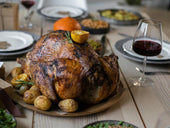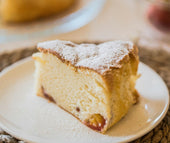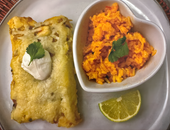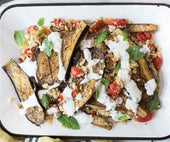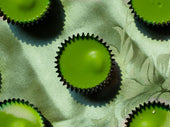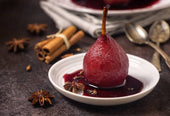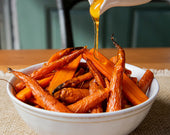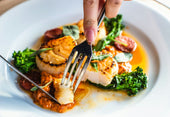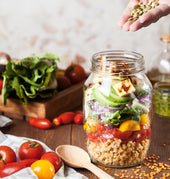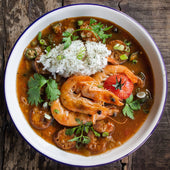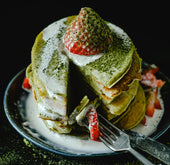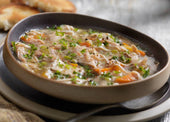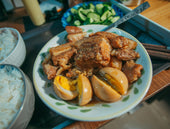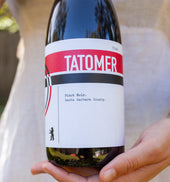
Pasteis de Nata

- 2 cups minus 2 tablespoons all-purpose flour
- 1/4 teaspoon sea salt
- 3/4 cup plus two tablespoons water
- 16 tablespoons unsalted butter, room temperature, stirred until smooth
Ingredients for the Custard:
- 3 tablespoons all-purpose flour
- 1 1/4 cups milk, divided
- 1 1/3 cups granulated sugar
- 1 cinnamon stick
- 2/3 cup water
- 1/2 teaspoon pure vanilla extract
- 6 large egg yolks, whisked
- Powdered sugar
- Cinnamon
- In a stand mixer fitted with a dough hook, mix the flour, salt, and water until a soft, pillowy dough forms that cleans the side of the bowl, about 30 seconds.
- Generously flour a work surface and pat the dough into a 6-inch square using a pastry scraper as a guide. Flour the dough, cover with plastic wrap, and let it rest for 15 minutes.
- Roll the dough into an 18-inch square. As you work, use the scraper to lift the dough to make sure the underside isnt sticking.
- Brush excess flour off the top, trim any uneven edges, and using a small offset spatula dot and then spread the left two-thirds of the dough with a little less than one-third of the butter to within 1 inch of the edge.
- Neatly fold over the unbuttered right third of the dough (using the pastry scraper to loosen it if it sticks), brush off any excess flour, then fold over the left third. Starting from the top, pat down the packet with your hand to release air bubbles, then pinch the edges closed. Brush off any excess flour.
- Turn the dough packet 90 degrees to the left so the fold is facing you. Lift the packet and flour the work surface. Once again roll out to an 18-inch square, then dot and spread the left two-thirds of the dough with one-third of the butter, and fold the dough as in steps 4 and 5.
- For the last rolling, turn the packet 90 degrees to the left and roll out the dough to an 18-by-21-inch rectangle, with the shorter side facing you. Spread the remaining butter over the entire surface.
- Using the spatula as an aid, lift the edge closest to you and roll the dough away from you into a tight log, brushing the excess flour from the underside as you go. Trim the ends and cut the log in half. Wrap each piece in plastic wrap and chill for 2 hours or preferably overnight.
- In a medium bowl, whisk the flour and 1/4 cup of the milk until smooth. Set aside.
- Bring the sugar, cinnamon, and water to a boil in a small saucepan and cook until an instant-read thermometer registers 220°F (100°C). Do not stir.
- Meanwhile, in another small saucepan, scald the remaining 1 cup milk. Whisk the hot milk into the flour mixture.
- Remove the cinnamon stick then pour the sugar syrup in a thin stream into the hot milk-and-flour mixture, whisking briskly. Add the vanilla and stir for a minute until very warm but not hot. Whisk in the yolks, strain the mixture into a bowl, cover with plastic wrap, and set aside.
- Assemble and bake the pastries
- Heat the oven to 550°F (290°C). Remove a pastry log from the refrigerator and roll it back and forth on a lightly floured surface until its about an inch in diameter and 16 inches long. Cut it into scant 3/4-inch pieces. Place a piece cut-side down in each well of a nonstick 12-cup mini-muffin pan (2-by-5/8-inch size). Allow the dough pieces to soften several minutes until pliable.
- Have a small cup of water nearby. Dip your thumbs into the water, then straight down into the middle of the dough spiral. Flatten it against the bottom of the cup to a thickness of about 1/8 inch, then smooth the dough up the sides and create a raised lip about 1/8 inch above the pan. The pastry sides should be thinner than the bottom.
- Fill each cup 3/4 full with the slightly warm custard. Bake the pasteis until the edges of the dough are frilled and brown, about 8 to 9 minutes.
- Remove from the oven and allow the pasteis to cool a few minutes in the pan, then transfer to a rack and cool until just warm. Sprinkle the pasteis generously with powdered sugar, then cinnamon and serve. Repeat with the remaining pastry and custard. If you prefer, the components can be refrigerated up to three days. The pastry can be frozen up to three months.
Makes 1-2 dozen depending on muffin pan size. Recipe adapted from Leites Culinaria
 Contributed by Monica Yu , Assistant Wine Buyer for Plume Ridge Bottle Shop
Contributed by Monica Yu , Assistant Wine Buyer for Plume Ridge Bottle Shop


